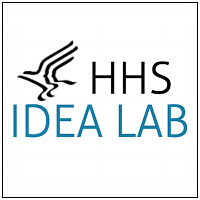 By Kristen Honey, Innovator in Residence, HHS Office of the CTO; Justin Koufopoulos, Presidential Innovation Fellow, GSA; Gil Alterovitz, Presidential Innovation Fellow, GSA
By Kristen Honey, Innovator in Residence, HHS Office of the CTO; Justin Koufopoulos, Presidential Innovation Fellow, GSA; Gil Alterovitz, Presidential Innovation Fellow, GSA
Twitter: @HHSIDEALab
As part of its innovation efforts around digital health, the Office of the Chief Technology Officer (CTO) announces a new pilot program modeled after The Opportunity Project (TOP) led by the Census Bureau at U.S. Department of Commerce. TOP is a pioneering model for public-private collaboration to tackle complex challenges with data, technology, and agile methods. Teams turn federal open data—datasets and resources freely available and open to the public on Data.gov—into new digital tools. TOP is a design sprint that puts users and people first, while facilitating new collaborations across government, industry, academia, nonprofits, and diverse stakeholders.
The Office of the CTO will lead this 14-week tech sprint as part of its mission to provide leadership and direction for innovation and digital solutions across the Department of Health and Human Services (HHS). HHS CTO will use the TOP methodology to connect tech teams with outside-the-box thinking and collaboration across silos for solutions. The sprint will launch in October 2018 in collaboration with the Presidential Innovation Fellows who are agents of innovation and change within Federal agencies.
Similar to past TOP sprints and demo days, this tech sprint will focus on big problems that demand cross-sector solutions. Tech teams will join a cohort with subject matter experts to tackle one of two health-related challenges:
Challenge #1:
Artificial Intelligence (AI) for approaches for facilitating an experimental therapy ecosystem.
How can we do better by leveraging standards and emerging technologies?
Team Mission: Create digital tools that help in finding experimental therapies for patients, and vice versa.
The 21st Century Cures Act of 2016 established priorities for initiatives across Federal agencies to reduce roadblocks and enable work toward new therapeutics. One of the chief obstacles to the timely completion of clinical trials is recruitment of participants. To improve the precision of searching for experimental therapeutics, whether they be in clinical trials or under the “Right to Try” Act of 2017, this work proposes testing approaches for structuring eligibility criteria to make it be easier to find relevant experimental therapeutics (and clinical trials, where applicable) without having to a read through a large number of trial protocol texts manually.
Challenge #2:
Harness the power of collaboration, citizen science, and data for Lyme disease.
How can we address Lyme and tick-borne disease through emerging technologies by coupling the power of the crowd and patient insights with data?
Team Mission: Create digital tools and data sharing capabilities for the prevention, education, and science that will support data-driven decisions and improve public health related to tick-borne disease.
Lyme disease is a tick-borne bacterial infection that affects more than 300,000 patients annually in the United States—more Americans than HIV/AIDS and breast cancer combined. There is no vaccine and an estimated 10-20% of treated Lyme disease patients fail to recover fully. A comprehensive understanding of the full economic and societal cost remains unknown, yet emerging estimates indicate that Lyme disease costs the United States tens of billions of dollars each year. Domestically, it is the fastest-growing vector-borne disease today. In the last 20 years, the number of U.S. counties with Lyme disease has doubled and those considered “high incidence” for Lyme disease have increased by greater than 300% in the northeastern states and by approximately 250% in the north-central states. This growing problem takes a toll on individuals affected, their families, and Federal government programs.
Innovation often comes from unexpected places. Solutions demand all hands on deck! Join us!
Interested in learning more or being a tech team?
Please email HHS Office of the CTO for more information: cto@hhs.gov
This article was originally published on HHS Idea Lab and is republished here with permission.
